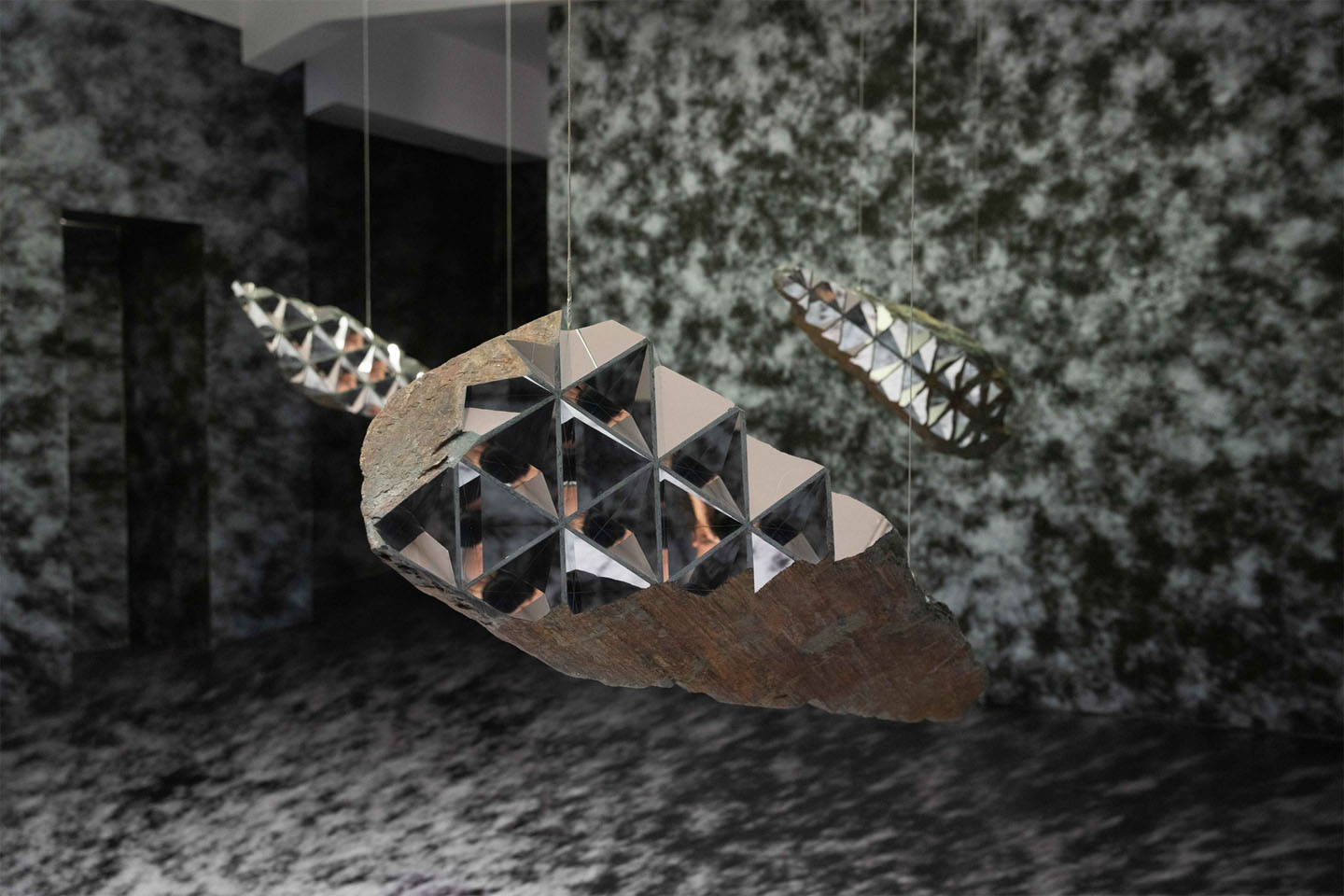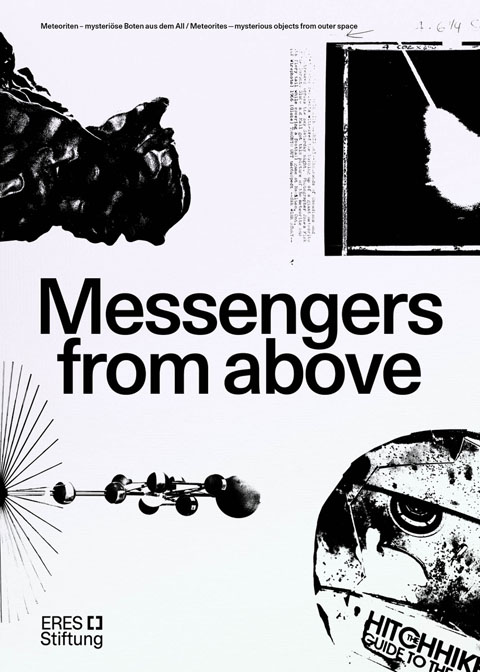Messengers From Above
Meteorites – mysterious objects from outer space
5 December 2024 – 27 September 2025

Julius von Bismarck, Time Apparatus, 2022, Courtesy the artist and alexander levy, Berlin, © Julius von Bismarck; VG Bild-Kunst, Bonn 2024, Foto: Julius von Bismarck
Videos
© München TV, Culture Talk, Markus Stampfl, 3. Dezember 2024
(Video: 205.84 MB)
Artists
Yael Bartana, Julius von Bismarck, Albrecht Dürer, Bogomir Ecker, Rodney Graham
Wolfgang Kaiser, Lukas Kindermann, Sonia Leimer, Olaf Nicolai, Regine Petersen, James Rosenquist, Charles Stankievech
Exhibition
Will the sky fall on our heads one day? Meteorites have a magical attraction, but at the same time they fuel age-old fears. Whereas in the Middle Ages they were regarded as divine signs and ominous devil’s stones, today people fear a natural disaster: a meteorite impact that could wipe out our civilisation. Perhaps not such a far-fetched thought. After all, according to scientific studies, the impact of a cosmic colossus several kilometres in diameter around 66 million years ago is said to have caused massive climate change and led to the extinction of the dinosaurs. Is there a threat of a repeat? Do we need to prepare to leave the Earth? For the time being, there is no reason to worry, as planetary defence programmes from NASA or ESA have their sights firmly set on potentially dangerous large calibres from space. Innovative technologies could even prevent a collision in an emergency by manipulating the trajectory and course of the asteroids.
Countless pieces of extraterrestrial rock enter the Earth’s atmosphere every day. Because they are often only the size of a grain of dust, they usually burn up unnoticed. Larger specimens light up as fireballs in the firmament, admired as “shooting stars” or meteors. Some debris makes it to the earth’s surface as meteorites. Bang on impact – as happened most recently in Germany in January 2024 near Ribbeck, north-west of Berlin. Meteorites leave behind fascinating traces, not only in the form of cratered landscapes or destroyed buildings. The mysterious messengers from space also harbour exciting secrets and are important information carriers for science. It is highly probable that meteorites were involved in the origin of life. It has only recently been proven that some of them contain organic substances such as water and amino acids. A groundbreaking discovery.
In the ERES Foundation’s new exhibition, the primordial matter of the solar system becomes a “time capsule”, a valuable information carrier for art and science. While researchers hope to draw conclusions about the origin and future of life from these rare lumps of stone or metal, artists are reading the extraterrestrial data storage devices in a multifaceted wealth of contemporary positions: Utopian-dystopian visions and works full of humour and poetry penetrate the atmosphere of the exhibition spaces, questioning chance, probability and again and again the position of us humans in the great cosmic structure. Will we need an interplanetary Noah’s Ark?
Wissenschaftsprogramm
-
Thursday, 30 January 2025, 7 pm
Kosmische Narben
Einschlagkrater als Zeugen gewaltiger Kräfte aus dem All
Prof. Dr. Thomas Kenkmann, Institut für Geo- und Umweltnaturwissenschaften, Albert-Ludwigs-Universität Freiburg -
Thursday, 13 February 2025, 7 pm
Bausteine, die vom Himmel fallen
Brachten Meteoriten das Leben auf die Erde?
Prof. Dr. Dr. h.c. Thomas Henning , Direktor Emeritus am Heidelberger Max-Planck-Institut für Astronomie -
Thursday, 6 March 2025, 7 pm
Hazard by Numbers
Wie wahrscheinlich ist die Auslöschung der Menschheit durch einen Asteroideneinschlag?
Dr. Richard Moissl, Head of Planetary Defence Office,
European Space Agency (ESA)
Catalogue
Accompanying the exhibition is a catalogue (german/english), EUR 10,00
Order via Catalogues

Reviews
-
MESSENGERS FROM ABOVE Meteoriten – mysteriöse Boten aus dem All
Kunstforum, Band 302, Jolanda Drexler
Artikel als pdf -
Tanz mit den Meteoriten
artline Kunstmagazin, 03/2025, Roberta De Righi
Artikel als pdf -
Der Tag, an dem die Welt nicht unterging
Süddeutsche Zeitung Extra, 26. Februar 2025, Evelyn Vogel
Artikel als pdf -
Botschafter aus dem All: Meteoriten!
Kulturmagazin Capriccio, BR Fernsehen, 23. Januar 2025
Video in der ARD Mediathek -
Urmaterie des Sonnensystems
Münchner Feuilleton, Januar 2025, Bettina Wagner‑Bergelt
Artikel als pdf -
»Messengers from above« – Meteoriten und Kunst, eine Ausstellung in München
Deutschlandfunk, 01. Januar 2025, Julian Ignatowitsch
Audio auf deutschlandfunk.de -
Ganz schön galaktisch
Abendzeitung, 13. Dezember 2024, Roberta De Righi
Artikel als pdf -
Galaktische Gefühle
Münchner Merkur, 11. Dezember 2024, Alexander Altmann
Artikel als pdf -
Mysteriöse Boten aus dem All: Ausstellung über Meteoriten
Bayern2, Die Welt am Morgen, 4. Dezember 2024, Julian Ignatowitsch
Audio auf br.de -
Messengers from above: Meteoriten – mysteriöse Boten aus dem All in der ERES Stiftung
München TV, Culture Talk, 3. Dezember 2024, Markus Stampfl
Video auf muenchen.tv
Audios

Mysteriöse Boten aus dem All: Ausstellung über Meteoriten
Bayern2, Die Welt am Morgen, Julian Ignatowitsch,
4. Dezember 2024
(Audio: 7.86 MB)

Meteoriten in der Kunst – Gespräch mit Sabine Adler
Bayern2, Kulturleben, Julian Ignatowitsch,
4. Dezember 2024
(Audio: 14.43 MB)

Rodney Graham, Vexation Island, 1997 (film still), © The Estate of Rodney Graham
